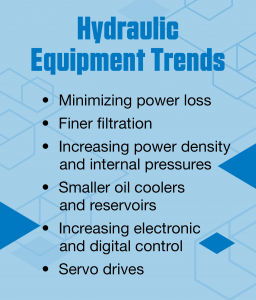How the Global Hydraulic Fluid Market Is Changing—And What It Means for the Future
The size of the worldwide hydraulic fluids market is expected to be worth $77.5 billion by the end of 2021 and this growth is expected to continue year on year through 2024.
That’s why smart lubricant manufacturers see it as one of the most lucrative opportunities at their disposal. To capitalize on this opportunity, however, it’s important to understand the current state of play of the hydraulic fluids market, as well as the trends and challenges that face the market moving forward. To that end, this article helps to identify where the industry currently is and where it is likely headed. Here’s what you need to know:
Market Overview
Currently, the global hydraulics market is made up of two primary segments: industrial equipment and mobile hydraulics. Industrial equipment makes up nearly 35% of the market. The mobile hydraulics side of the business is a much larger opportunity for lubricant manufacturers, representing the other 65% of the market.
Interestingly, the growth of the hydraulic lubricant market does not directly mirror the speed with which the broader hydraulic market is growing, in part because oil sump volumes are decreasing and oil drain intervals are being extended due to higher quality fluids being utilized. These ongoing trends minimize operating costs for end users and require less overall lubricant to operate machinery.
Hydraulic Equipment Trends
Change is occurring rapidly in the hydraulic equipment market. As new technologies allow for more efficient hydraulic equipment operation, the lubricant market is changing to meet its reliability needs. The most important trends include:
Minimizing power loss. In today’s hydraulic equipment, there’s much more emphasis on reducing power losses and increasing overall machine efficiency by limiting the number of bends, joints and filter pressure differential. In addition, original equipment manufacturers (OEMs) are focused on saving every bit of energy they can and are turning to energy-efficient hydraulic fluids to accomplish this goal.
Finer filtration. Due to the environments they operate in, hydraulic pumps are vulnerable to contamination, in part resulting from increased pressures and decreased clearances in pumps and valves, the fluids used to lubricate them must be ultraclean. In response, OEMs are specifying finer filters that meet ISO 4406 standards. With wet filterability becoming an essential fluid performance parameter, hydraulic fluids are tested during development to ensure they don’t block these filters, which also have increased dirt-holding capacity. Glass fibers in the finer filters increase their surface area but generate increased static, which is potentially hazardous.
Increasing power density and internal pressures. As hydraulic systems continue to evolve, they are increasingly lighter and more power dense to compete effectively with the electric systems that are moving into the market. Smaller pumps that maintain the same power levels are more common in today’s applications in an attempt to lower fuel consumption in mobile applications. The resulting higher internal pressure, which can be as much as 450 bars in current mobile equipment, is expected to continue its upward trajectory.
Higher system pressure is made possible by reducing the clearances between moving parts. This reduction can cause major machine durability issues if the system is not suitably lubricated. High pressure piston pumps typically operate in the hydrodynamic regime of lubrication, but modern fluids are expected to provide the same high level of performance and protection in every regime of lubrication.
Smaller oil coolers and reservoirs. Oil coolers and reservoirs are significantly smaller in today’s modern equipment, as designers aim to save space and reduce weight, leading to significantly increased operating temperatures. In such conditions, the fluid’s effective operating life is significantly reduced, though lubricants with good thermal stability and antioxidant properties can extend their effectiveness. In addition, hydraulic oils find themselves under more stress due to lower volume systems becoming the norm and are expected to provide the same level of protection regardless. As a result, lubricants may need increased additive-treat levels because they will be consumed more quickly under these conditions.
Increasing electronic and digital control. Modern hydraulic systems are likely to be controlled electronically, meaning hydraulic pressure and flow can be managed precisely to work in specific duty cycles. For example, most construction equipment OEMs employ electric drives but still have hydraulic systems in their machines.
Increasingly, modern hydraulic equipment uses digital valves, which allow for more precise control of the equipment. Since these valves are 25 to 100 times faster than analog valves, modern hydraulic lubricants must have low air content and compressibility so they do not impede valve operation.
Servo drives. These innovative pieces of equipment increase the energy efficiency of hydraulic equipment by up to 30% by allowing the system to stop and start quickly. To achieve these savings, they use smaller internal volumes of high-tier hydraulic fluids with good thermal stability, low sludge performance and excellent varnish mitigation.
Implications for Hydraulic Fluids
To meet these new demands, modern hydraulic lubricants and fluids must evolve in several areas:
Efficiency. No matter how you measure it (lower fuel/electricity consumption, more work completed per shift, easier cold start-up or any other criteria), OEMs and operators are looking to improve efficiencies to give them advantages over their competition. While they could improve efficiency with costly engineering upgrades, using more efficient hydraulic fluids can achieve the same goals at much lower costs. Used properly, high-performance lubricants can lower the total cost of ownership for fleet owners and end users.
Extended oil drain intervals (ODIs). When draining and replacing hydraulic fluids, operators lose productivity, which translates into generating less revenue. Draining and flushing before refilling is a major source of inconvenience to all operators but particularly those with autonomous systems. The use of premium hydraulic fluids can extend the time between these necessary operations without compromising durability and performance. While recommended drain intervals depend on the OEM, most suggest using lubricants that prolong ODIs.
Stick/slip performance. In modern hydraulic equipment, OEMs are trying to reduce friction and noise to improve the productivity of their machines. Properly developed fluids and high-quality hydraulic hoses can help achieve these goals, though they must not compromise on the protection of the machine components.
Conductivity. Fluid conductivity is becoming more important in new hydraulic equipment, as OEMs worry about finer fibers in oil filters, higher oil flow rates and non-conductive circuits. Conductivity concerns, however, produce new formulation challenges, particularly on start-up with a cold fluid. Once the machine is in operation and the fluid warms up, conductivity improves, and the possibility of static discharge becomes less of a concern.
Wear performance. No matter what challenges are presented by modern hydraulic equipment, the essential function of a hydraulic fluid—to protect the machine’s components from undue wear—does not change. Protection must never be sacrificed to make improvements in other areas of hydraulic fluid development.
Sustainability. The environmental effects of hydraulic fluids are increasingly under scrutiny as the world turns its attention to issues of sustainability. This pressure is being felt by lubricant manufacturers across the industry and is one of the most important factors driving research today. After all, leaks and spills, equipment breakdown or careless disposal can inadvertently expose the environment to large amounts of hydraulic fluid. Modern hydraulic fluid development must be mindful of that reality and should focus on sustainable and biodegradable formulations.
It is important to mention that many legacy specifications do not adequately cover the performance challenges outlined above that fluids face in modern hydraulic equipment. The best way forward for OEMs and lubricant manufacturers is to collaborate on the development of new testing methods which elevate the (often theoretical) level of performance required by laboratory testing, to help them better represent the real-world demands of modern lubricants. This way, the next generation of hydraulic fluids can easily meet the requirements of today and tomorrow’s hydraulic equipment.
About the authors: 
Adrian Fitzpatrick, global industrial OEM manager, has been with Lubrizol for 25 years where he has held different technical and commercial roles. Adrian initially worked as a mechanical engineer in the mechanical testing laboratory with a focus on industrial and driveline test rigs, including hydraulic test rigs. A few years later, he managed Lubrizol’s European mechanical testing laboratory in Hazelwood, England. He has also held many positions on European test development committees. He has a bachelor’s degree in mechanical engineering from the University of Nottingham.
Technology Deployment Manager Matt Thom joined Lubrizol in 2014 after earning his bachelors of science and masters of chemistry from Nottingham Trent University. Since 2015, he has been working in the industrial specialties department supporting key business developments in industrial gear oil and hydraulic end uses. He also works closely with the OEM team to gain and maintain Industrial’s key OEM approvals.




 Power Transmission Engineering is THE magazine of mechanical components. PTE is written for engineers and maintenance pros who specify, purchase and use gears, gear drives, bearings, motors, couplings, clutches, lubrication, seals and all other types of mechanical power transmission and motion control components.
Power Transmission Engineering is THE magazine of mechanical components. PTE is written for engineers and maintenance pros who specify, purchase and use gears, gear drives, bearings, motors, couplings, clutches, lubrication, seals and all other types of mechanical power transmission and motion control components.